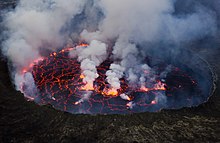
A volcanogenic lake is a lake formed as a result of volcanic activity. [1] They are generally a body of water inside an inactive volcanic crater ( crater lakes) but can also be large volumes of molten lava within an active volcanic crater ( lava lakes) and waterbodies constrained by lava flows, pyroclastic flows or lahars in valley systems. [2] The term volcanic lake is also used to describe volcanogenic lakes, although it is more commonly assigned to those inside volcanic craters. [3] [4] [1] [2]
Volcanic crater lakes

Lakes in calderas fill large craters formed by the collapse of a volcano during an eruption. Examples:

Lakes in maars fill small craters where an eruption deposited debris around a vent. Examples:
- Lake Nyos, Northwest Region, Cameroon
- Lac Pavin, Puy-de-Dôme, France
- Soda Lakes, Nevada, United States
Lava lakes

These are some examples of rare lava lakes where molten lava in a volcano maintains relative equilibrium, neither rising to overflowing nor sinking to drain away.
- Mount Erebus, Ross Island, Antarctica
- Erta Ale, Afar Region, Ethiopia
- Mount Nyiragongo, North Kivu, Democratic Republic of the Congo
Lava-dammed lakes

- Lake Balık, Ağrı Province, Turkey
- Lake Disappear, North Island, New Zealand
- Garibaldi Lake, British Columbia, Canada
- Lake Güija, Guatemala/ El Salvador
References
- ^ a b Manville, V.; Hodgson, K. A.; Nairn, I. A. (2007). "A review of break-out floods from volcanogenic lakes in New Zealand". New Zealand Journal of Geology and Geophysics. 50 (2). The Royal Society of New Zealand: 131. Bibcode: 2007NZJGG..50..131M. doi: 10.1080/00288300709509826. ISSN 0028-8306. S2CID 129792354.
- ^ a b Manville, V. (2015). "Volcano-Hydrologic Hazards from Volcanic Lakes". Volcanic Lakes. Advances in Volcanology. Springer Science+Business Media. p. 22. ISBN 978-3-642-36832-5.
- ^ Robert K. Lane, Lake at the Encyclopædia Britannica
- ^ Pasternack, Gregory B. "Volcanic Lakes". Pasternack Lab. University of California, Davis. Retrieved 2019-11-20.
Further reading
- Delmelle, Pierre; Bernard, Alain (2000). "Volcanic Lakes". In Sigurdsson, Haraldur (ed.). Encyclopedia of Volcanoes. San Diego: Academic Press (published 1999). pp. 877–895. ISBN 978-0-12-643140-7.
- Christenson, B. W. (2000). Varekamp, Johan C.; Rowe, Gary L. Jr. (eds.). "Crater Lakes". Journal of Volcanology and Geothermal Research. 97 (1–4): 1–508. Bibcode: 2000JVGR...97....1C. doi: 10.1016/S0377-0273(99)00167-5. (entire volume about crater lakes)
- Pasternack, G. B.; Varekamp, J. C. (1997). "Volcanic lake systematics I. Physical constraints". Bulletin of Volcanology. 58 (7): 526–538. Bibcode: 1997BVol...58..528P. doi: 10.1007/s004450050160. S2CID 140598280.
- Kusakabe, Minoru, ed. (1994). "Geochemistry of Crater Lakes". Geochemical Journal. 28 (3): 137–306. doi: 10.2343/geochemj.28.137. (entire issue about chemistry of crater lakes)
External links
- IAVCEI Commission of Volcanic Lakes
- IAVCEI Commission of Volcanic Lakes: Some fundamentals about Crater Lakes
- The Science of Volcanic Lakes
- Volcanic Lakes of the World
- USGS Hawaiian Volcano Observatory: Water on volcanoes: heavy rain and crater lakes
- USGS Cascades Volcano Observatory: Volcanic Lakes
- The Science of Volcanic Lakes, Greg Pasternack, U. California Davis
- Crater Lake National Park documentation in Building Oregon: Architecture of Oregon & the Pacific Northwest archive
- World Volcanic Lakes Map